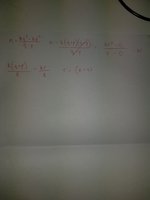A quadratic function has equation f(x) = kx^2. P and Q are points on the parabola with x-coordinates p and q, respectively. A straight line, parallel to PQ, is drawn from the origin O, to the point R. The x-coordinate of R is r.
Show that r = k(p+q).
Have no idea where I'm going with this, any help would be appreciated.
Show that r = k(p+q).
Have no idea where I'm going with this, any help would be appreciated.

